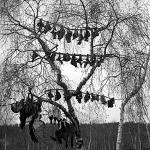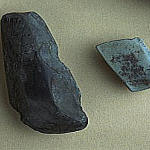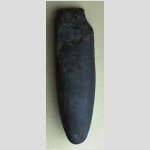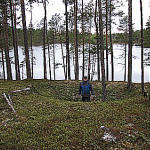

Home
Area
Vätsäri
Övre Pasvik
Pasvik Zapovednik
Nature
Geology
Climate
Water system
Flora
Fauna
Culture
Population
Religion
Sources of livelihood
Old ways of life
Time of industrialism
History
Stone Age
Early Metal Age
Late Metal Age
Middle Ages
Towards modern times
Timeline
Cooperation
Nature monitoring
Nature tourism
Publications
Contacts
Visit Pasvik-Inari
Guidelines
Regulations
News
Links
The Stone Age
People arrive to the north
The last Quaternary Ice Age finished in Inari - Paatsjoki area approximately 10 000 years ago. Then the climate changed drastically and the vegetation started to spread to the land which was rising, released from the pressure of a 3-kilometre thick ice cover. At first, Lake Inarijärvi was only a bay of the Arctic Ocean, but by land uplift it was isolated as a lake and the River Pasvik became its discharge into the sea.
The first Stone Age settlement, representatives of the so-called Komsa culture, arrived in the Inari-Pasvik area possibly from the Ruija sea coast because the shoreline had been free from ice there longer than inland. When the second wave of settlement arrived in the area later on from the south and east, the North Calotte turned into a meeting place of three different populations.
The oldest Stone Age dwelling sites around Lake Inari are dated to 8000 BC by radiocarbon dating taken from the charcoals of fireplaces and chewing resin. Dwellings sites from the banks of the Pasvik River are younger. The first Stone Age dwelling site in Pasvik River was found on the Russian side of the river, on Vaarlam Island (Vaarlamansaari/Niilansaari), in 1901. The richest and largest dwelling sites of Pasvik River are situated on the Norwegian side of the river, in Noatun. The rationing of Lake Inari and the building of hydraulic power stations have, without any doubt, destroyed several prehistorical sites, but many sites are certainly still waiting to be found.
Annual cycle regulated daily life
Small hunter-gatherer societies followed the moving animals and other sources of livelihood along the annual cycles. People travelled to the same comfortable dwelling sites for many centuries as their ancestors had done before them. In prehistoric times, watercourses were normal travelling routes in summer and winter, and Pasvik River formed a straight route from Lake Inari to the Arctic Ocean.
In winter the moving population came together to the common settlement sites of Varangerfjord coast. Dwellings were partly dug into the ground and covered with turf roof. In springtime, the inhabitants of these winter villages spread into the smaller family groups who travelled to the different sites on which they could fish, hunt migrating birds and gather eggs. By summer, the groups had moved inland along the rivers and settled in the summer places where their main livelihood was fishing. In the autumn, people hunted wild deer. Many hunting pit systems found from the Pasvik River area exist still today and attest to the ancient hunting method which has been in use up to historical times.
Tools and raw materials
In the Stone Age, the raw material used for tools, such as scrapers, knives, arrowheads, hooks and axes were mainly different kinds of stones. Of course, objects were also manufactured from various kinds of organic materials, from bone, antler, wood and skin, but they cannot be found from the dwelling sites in the archaeological excavations anymore because the acid soil has made them disappear. Swamps can preserve the prehistoric organic materials, but there have been no Stone Age swamp finds in the Pasvik-Inari area so far.
The ability to make pottery spread to the north through Carelia, Aunus and Southern Finland from central Russia. The arrival of pottery reflects probably changes in the Stone Age economy and society. The oldest finds can be dated to approximately 4700 BC in the Pasvik-Inari area. This so-called Säräisniemi I or Pasvik River type pottery was prepared in a wide area from Inari to the Kuola peninsula. The half egg-shaped vessels were decorated with various stamps, and their typical height was around 40 cm and cubic capacity 8-10 litres.



